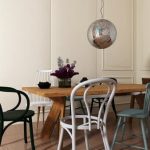Wood is a timeless and versatile material that plays a significant role in home decor. From furniture and flooring to accents and trim, the use of wood can add warmth, character, and natural beauty to any space. But does mixing shades of wood matter in home decor? In this article, we will explore the impact of blending different wood tones and the important considerations to keep in mind when incorporating various shades of wood into your home design.
When it comes to interior design, the use of different types of wood and their natural shades can have a profound effect on the overall look and feel of a room. Understanding color theory is vital in determining how various wood shades can complement or clash with each other in home decor. By paying attention to the basics of wood and color theory, you can create a harmonious and visually appealing environment within your living space.
Creating balance is key when it comes to mixing different shades of wood in furniture and decor. From choosing complementary colors to considering the impact of lighting on various wood tones, there are several tips and tricks that can help you achieve a cohesive look. By exploring the impact of lighting, contrast, texture, we will uncover how intentional wood mixing can elevate your home decor while avoiding potential pitfalls along the way.
The Basics of Wood
Wood is a fundamental element in home decor, adding warmth, texture, and a sense of natural beauty to any space. When considering the use of wood in interior design, it’s essential to understand the different types of wood and their natural shades. From light maple to rich mahogany, each type of wood has its own unique color and grain pattern that can significantly impact the overall aesthetic of a room.
One key question that often arises in home decor is: does mixing shades of wood matter? The answer is yes. Different wood shades have the potential to complement or clash with each other, so understanding the basics of wood is crucial for creating a cohesive and visually appealing design.
Lighter woods such as pine and oak can create an airy and casual feel, while darker woods like cherry and walnut convey a sense of richness and sophistication. Knowing how to effectively mix these different shades can make all the difference in achieving a balanced and harmonious look.
In addition to varying natural shades, different types of wood also have unique grain patterns that add character and visual interest to furniture and decor. For example, oak typically has prominent grain lines, while maple offers a smoother and more uniform appearance.
Understanding these differences can help homeowners make informed decisions when selecting wood furniture or accents for their space. By paying attention to both color and grain pattern when mixing shades of wood, individuals can create a dynamic yet cohesive design scheme in their homes.
Understanding Color Theory
When it comes to home decor, the use of wood can have a significant impact on the overall look and feel of a space. The natural warmth and beauty of wood can add a sense of coziness and elegance to any room. However, when it comes to mixing different shades of wood in home decor, there are some important considerations to keep in mind. Understanding color theory is essential in order to create a cohesive and visually appealing design.
Different types of wood have their own distinct natural shades, ranging from light tones like pine and birch to darker tones like cherry and mahogany. When mixing these different wood shades in home decor, it’s important to consider how they interact with each other. Lighter woods tend to create a more airy and modern feel, while darker woods can add richness and depth to a room.
In terms of color theory, it’s important to think about how different wood shades can complement or clash with each other in home decor. Consider the undertones of each wood type – whether they have warm or cool undertones – and how they will interact with the other elements in the room, such as wall color, furniture pieces, and flooring. Here are some key points to keep in mind when considering mixing shades of wood in home decor:
- Use complementary colors: Pair lighter woods with darker ones that have complementary undertones for a cohesive look
- Consider contrast: Incorporate contrasting wood shades for added visual interest
- Pay attention to saturation: Balance out highly saturated wood colors with muted or neutral tones for a more harmonious blend
Creating Balance
When it comes to home decor, the use of different shades of wood can create a warm and inviting atmosphere. However, it is important to consider how these different shades work together in order to achieve a harmonious look. So, does mixing shades of wood matter in home decor? The answer is yes, it definitely does matter. Mixing different wood shades can either elevate the overall design or create a jarring effect if not done thoughtfully.
Here are some tips and tricks for creating balance when mixing shades of wood in furniture and decor:
- Identify a dominant wood tone: Choose one shade to be the dominant tone in the room, whether that’s the flooring, main furniture pieces, or prominent architectural features. This will help anchor the space and create a cohesive look.
- Use varying textures: Incorporating different textures alongside various wood tones can add visual interest to a room while still maintaining balance. For example, pair smooth oak with rough cedar or distressed walnut with polished maple.
- Consider contrast: If you have dark wood floors, consider using lighter wood furniture pieces to create contrast. This will help prevent the space from feeling too heavy or one-dimensional.
By following these tips and tricks, you can create a harmonious look when mixing shades of wood in furniture and decor. Keep in mind that achieving balance is key when incorporating different wood tones into your home decor. With careful consideration and thoughtful planning, you can create a space that feels cohesive and visually appealing.
The Impact of Lighting
When it comes to home decor, lighting plays a crucial role in the way different shades of wood are perceived in a room. Natural and artificial light can significantly impact the appearance of wood, making it essential to consider lighting when mixing different wood shades.
Natural light can bring out the natural beauty of wood, enhancing its warmth and richness. Depending on the direction and intensity of sunlight, different wood grains and tones can be highlighted or subdued.
Additionally, artificial lighting such as overhead fixtures, lamps, and accent lights can also influence the way wood shades are perceived in a space. It is important to consider the color temperature and brightness of artificial lighting to ensure that the true colors of your mixed wood pieces are accurately represented.
In rooms with ample natural light, subtle variations in wood shades may be more noticeable. Conversely, in spaces with limited natural light or darker corners, the differences between various wood shades may appear less pronounced.
Understanding how lighting can affect the appearance of mixed wood is crucial for achieving a cohesive and balanced look in home decor. By paying attention to how natural and artificial light interacts with different wood shades, you can create an aesthetically pleasing and harmonious environment within your home.
Contrast and Texture
When it comes to home decor, the use of different wood shades can create a sense of depth and visual interest in a space. The contrast between light and dark wood tones can add dimension to a room, making it feel more dynamic and visually appealing. This contrast can also help highlight the unique features of each piece of furniture or accent, adding character to the overall design.
In addition to creating contrast, mixing different wood shades can also introduce texture into a room. Whether it’s through the grain patterns or the sheen of the wood finish, combining various wood tones can bring a tactile element to the design. This tactile quality not only adds visual interest but also invites touch, making the space feel more inviting and warm.
In order to successfully incorporate this technique into your home decor, it’s important to consider the overall color palette of the room. While mixing wood shades can create contrast and texture, it’s essential to ensure that they work cohesively with the existing colors in the space. By paying attention to color theory and coordinating different wood tones with other elements in the room, you can achieve a balanced and harmonious look that enhances the overall aesthetic.
| Impact | Details |
|---|---|
| Visual Interest | Mixing different wood shades creates depth and adds visual appeal |
| Texture | Combining various wood tones introduces tactile elements into the space |
| Color Coordination | Considering color theory ensures a balanced and cohesive look when mixing wood shades |
Practical Examples
When it comes to mixing shades of wood in home decor, seeing real-life examples can be incredibly helpful. Whether you’re looking to incorporate multiple wood tones in your furniture, flooring, or accents, practical examples can provide inspiration and guidance for achieving a harmonious and visually appealing look in your home.
Furniture
One common way to mix shades of wood in home decor is through furniture pieces. For example, you might have a dining table in a deep walnut finish accompanied by chairs with lighter oak legs. This creates a sense of contrast and visual interest while still maintaining a cohesive overall look. Another option could be blending different wood finishes within the same furniture piece, such as a dresser with natural maple drawers and a rich cherry wood frame.
Flooring
Mixing wood shades in flooring can also have a striking effect on the overall aesthetic of a space. For instance, combining light maple hardwood with dark walnut borders can create an eye-catching pattern that adds depth and dimension to a room. Alternatively, using varied wood tones to create unique geometric designs or herringbone patterns can elevate the visual appeal of your floors.
Accents
Incorporating different wood tones through accents such as shelving, picture frames, or decorative objects allows for an easy and impactful way to introduce variety into your decor. A combination of lighter pine shelving with darker mahogany picture frames can add texture and warmth to a room without overwhelming the space.
By showcasing these practical examples of successful wood mixing in home decor, it becomes clear that there are countless ways to achieve a balanced and harmonious look while incorporating different wood shades throughout your space. Whether it’s through furniture pieces, flooring patterns, or accent details, intentional wood mixing can bring depth and visual interest to any room.
Potential Pitfalls
When it comes to mixing shades of wood in home decor, there are potential pitfalls that can occur if not done intentionally and carefully. Understanding these common mistakes and how to avoid them is essential for creating a cohesive and balanced look in your living space.
Ignoring Undertones
One common mistake when mixing wood shades in home decor is ignoring the undertones of each type of wood. Different woods have subtle undertones that can be warm, cool, or neutral. Ignoring these undertones can result in clashing shades that do not complement each other.
To overcome this, it’s important to take the time to compare the undertones of different woods before incorporating them into your decor. Look for similarities in undertones to create a harmonious mix that enhances the overall aesthetic of the room.
Overloading on One Shade
Another pitfall when mixing wood shades is overloading on one particular shade. While it’s important to have a dominant wood tone in a room, using too much of one shade can create an unbalanced and overwhelming look. To avoid this, consider using the dominant wood tone for large furniture pieces or flooring, and then incorporate smaller accents in complementary or contrasting shades to add visual interest.
Neglecting Texture
Neglecting texture when mixing wood shades is also a common mistake in home decor. Using multiple wood tones without considering their textures can result in a flat and uninviting space. Overcome this by incorporating a variety of textures such as smooth finishes, distressed surfaces, or natural grains. This will add depth and dimension to the room while allowing different wood shades to complement each other effectively.
By being mindful of these potential pitfalls and taking deliberate steps to overcome them, you can successfully mix different shades of wood in your home decor while creating a visually appealing and harmonious environment. The key lies in understanding the natural characteristics of different woods, paying attention to color theory, and being intentional about creating balance through texture and contrast.
Conclusion
In conclusion, the question of whether mixing shades of wood matters in home decor can be answered with a resounding yes. The natural beauty and warmth of wood make it a popular choice for furniture, flooring, and accents in interior design. Understanding the basics of different wood types and their natural shades is essential in creating a cohesive and harmonious look when mixing various wood elements in a space.
Color theory plays a significant role in determining how different wood shades interact with each other. By understanding the principles of color harmony and contrast, homeowners can create balance and visual interest when incorporating mixtures of wood into their decor. Additionally, the impact of lighting cannot be ignored, as natural and artificial light can alter the appearance of various wood shades within a room.
When done intentionally and thoughtfully, mixing shades of wood in home decor can add depth, texture, and character to a space. By paying attention to contrast and texture, homeowners can create visual intrigue while maintaining a cohesive overall look. Lastly, practical examples showcase successful implementations of intentional wood mixing in home decor, serving as inspiration for those looking to incorporate this design element into their own homes.
Ultimately, the intentional mixing of shades of wood matters in home decor because it allows homeowners to create personalized, visually appealing spaces that reflect their unique style and taste. By understanding the basics of different woods, adhering to color theory principles, paying attention to balance and contrast, considering the impact of lighting, and learning from practical examples – individuals can successfully incorporate mixtures of wood into their interior design.
With careful planning and execution, intentional wood mixing can elevate the overall aesthetic appeal of any home.
Frequently Asked Questions
Do Different Shades of Wood Go Together?
Different shades of wood can definitely go together in a space. In fact, mixing different wood tones can add visual interest and depth to a room. The key is to balance the different shades so that they complement each other.
Does All the Wood in Your House Have to Match?
All the wood in your house does not have to match. In fact, having all the wood match exactly can make a space feel one-dimensional and overly coordinated. It’s more visually appealing to mix different wood finishes for a more dynamic look.
Can You Mix Dark and Light Wood in a Room?
Yes, you can absolutely mix dark and light wood in a room. In fact, this mixture can create a balanced and visually interesting space. Just be mindful of the proportions and distribution of the dark and light woods within the room to ensure harmony in the overall design scheme.

I’m thrilled to be your companion on this exciting journey through the world of home decor and design. With a passion for turning houses into homes and a keen eye for the finer details, I’m here to help you transform your living spaces into beautiful, functional, and meaningful havens.





